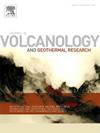Age-clustered eruptive activity at La Palma (Canary Islands) during the last 4000 years: Evidence from paleomagnetic dating
IF 2.3
3区 地球科学
Q2 GEOSCIENCES, MULTIDISCIPLINARY
Journal of Volcanology and Geothermal Research
Pub Date : 2025-03-31
DOI:10.1016/j.jvolgeores.2025.108328
引用次数: 0
Abstract
The detailed knowledge of timing and dynamics of pre-historic eruptions is pivotal for volcanic hazard assessment. This is most relevant for inhabited lower slopes of active basaltic volcanoes such as La Palma (Canary Islands), where the 2021 Tajogaite eruption caused severe destruction. We paleomagnetically investigated eight La Palma Holocene eruptions which are currently loosely constrained either by few radiometric (K/Ar and 14C) ages, or by stratigraphic/archaeological evidence. The paleomagnetic directions gathered from 28 sites (300 oriented cores) were compared with updated reference models of the paleo-secular variation of the geomagnetic field direction during the Holocene. Overlapping paleomagnetic directions from the Fuego and La Fajana lava flows, along with geologic and geochemical evidence, imply that the two flows were emplaced during the same eruptive event falling within the 2000–1730 BC time window. Single paleomagnetic age windows - consistent with and narrower than available 14C age intervals - were obtained for the Malforada–Nambroque, Montaña Quemada, and Fuego–La Fajana lava flows. Conversely, the Martín, Birigoyo–La Barquita, and La Caldereta flows yielded multiple age solutions. Moreover, our data show that the flanks of the pre-historic San Antonio scoria cone are almost totally covered by pyroclastic products of the nearby AD 1677 Fuencaliente eruption. The updated chronologic framework of the pre-historic volcanic activity at La Palma demonstrates that the past four kyr are characterized by an early period with low-frequency eruptions (three lava flow eruptions between ca. 2000 BC and 300 BC), followed by a ca. 1000 yr-long quiescence period, and by a subsequent clustering of nine events during the last 1100 yr (about one eruption per century).
拉帕尔马(加那利群岛)在过去4000年的年龄群喷发活动:来自古地磁测年的证据
对史前火山喷发的时间和动力学的详细了解是火山危险性评估的关键。这与拉帕尔马(加那利群岛)等活跃玄武岩火山的有人居住的较低斜坡最为相关,2021年的Tajogaite火山喷发造成了严重的破坏。我们对拉帕尔马全新世的8次喷发进行了古地磁研究,目前这些喷发要么受到少量辐射(K/Ar和14C)年龄的限制,要么受到地层/考古证据的限制。将28个测点(300个定向岩心)的古地磁方向与更新后的全新世地磁方向古长期变化参考模型进行了比较。富埃戈和拉法亚纳熔岩流的古地磁方向重叠,以及地质和地球化学证据表明,这两股熔岩流是在公元前2000年至1730年的同一次喷发事件中形成的。获得了Malforada-Nambroque、Montaña Quemada和Fuego-La Fajana熔岩流的单一古地磁年龄窗口,该窗口与现有的14C年龄间隔一致且更窄。相反,Martín、birigyoo - La Barquita和La Caldereta流动产生了多种年龄解决方案。此外,我们的数据显示,史前圣安东尼奥火山锥的两侧几乎完全被附近公元1677年Fuencaliente火山喷发的火山碎屑产物所覆盖。拉帕尔马史前火山活动的最新年代学框架表明,过去4年的特征是早期低频率喷发(约公元前2000年至公元前300年之间有3次熔岩流喷发),随后是约1000年的平静期,随后在1100年期间发生了9次事件(约每世纪一次喷发)。
本文章由计算机程序翻译,如有差异,请以英文原文为准。
求助全文
约1分钟内获得全文
求助全文
来源期刊
CiteScore
5.90
自引率
13.80%
发文量
183
审稿时长
19.7 weeks
期刊介绍:
An international research journal with focus on volcanic and geothermal processes and their impact on the environment and society.
Submission of papers covering the following aspects of volcanology and geothermal research are encouraged:
(1) Geological aspects of volcanic systems: volcano stratigraphy, structure and tectonic influence; eruptive history; evolution of volcanic landforms; eruption style and progress; dispersal patterns of lava and ash; analysis of real-time eruption observations.
(2) Geochemical and petrological aspects of volcanic rocks: magma genesis and evolution; crystallization; volatile compositions, solubility, and degassing; volcanic petrography and textural analysis.
(3) Hydrology, geochemistry and measurement of volcanic and hydrothermal fluids: volcanic gas emissions; fumaroles and springs; crater lakes; hydrothermal mineralization.
(4) Geophysical aspects of volcanic systems: physical properties of volcanic rocks and magmas; heat flow studies; volcano seismology, geodesy and remote sensing.
(5) Computational modeling and experimental simulation of magmatic and hydrothermal processes: eruption dynamics; magma transport and storage; plume dynamics and ash dispersal; lava flow dynamics; hydrothermal fluid flow; thermodynamics of aqueous fluids and melts.
(6) Volcano hazard and risk research: hazard zonation methodology, development of forecasting tools; assessment techniques for vulnerability and impact.

 求助内容:
求助内容: 应助结果提醒方式:
应助结果提醒方式:


